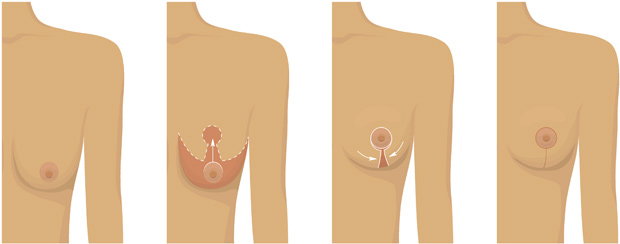- Downward pointing nipples, flatter or longer breasts, and nipples that fall below your breast crease are signs that you need a breast lift.
- The Pencil Test is one at-home method to determine your amount of breast droop.
- A breast lift removes extra skin, reshapes breast tissue, and raises the nipple/areola higher on the breast.
- A breast lift cannot add fullness.
We witness the changes in our breasts as we age, have children, and fluctuate our weight. But it's hard to tell whether we need a breast lift. Just because they are no longer youthful and perky doesn't mean surgery is necessary. The three signs of breast droop and the Pencil Test give us a better indicator.
Signs you need a breast lift
Long, flat breasts, nipples that point downward, and nipples that sit below your breast crease (inframammary fold) are signals you have breast droop and need a breast lift. Your areolae might also be large and stretched, or one breast might fall lower than the other.
The Pencil Test for sagging breasts
The simplest way to determine how saggy breasts are is to perform the Pencil Test. This quick at-home exam will tell you how low your nipples are compared to your breast crease.
Here's how it works:
- Stand in front of a mirror
- Lift your breast with one hand and place a pencil horizontally under your breast
- Let go of your breast
- Take note of how far your nipple is below the pencil
If you have ptosis, the scientific term for sagging breasts, your breasts will fall somewhere within five categories:
- Grade 1 ptosis: nipples are at or slightly below the breast crease.
- Grade 2 ptosis: nipples are below the breast crease.
- Grade 3 ptosis: nipples are significantly below the breast crease and pointing downward.
- Pseudoptosis: nipples are above the breast crease but the bottom of your breasts are sagging.
- Parenchymal maldistribution: there’s little lower breast tissue and the breast crease is high.

What is a breast lift (mastopexy)?
A breast lift (mastopexy) removes excess skin, reshapes breast tissue, and raises the nipple/areola higher on the breast. If you have the addition of large or stretched areola, the procedure can create a better proportion for a more natural-looking breast.
This outpatient procedure will take up to 3 hours and is performed under general anesthesia. Incisions are made around your areola and either along your breast creases or vertically from the areola to the breast creases. Excess breast skin is removed and stitches may be placed deep within the breasts to help reshape the breast tissue. The nipples are also resized (if you have large, stretched areolae) or staged for a higher position. The breast skin is then brought back together and closed with stitches. Surgical tape or skin adhesives may be placed as a barrier to protect the incision site.
Breast lift incision types and techniques
There are four breast lift incision types. They are made along different areas of the breast, some allowing for greater breast skin excision, nipple placement, and breast reshaping than others.
Crescent breast lift: minimal scarring for minimal sagging
A crescent breast lift involves creating a small incision halfway along the top edge of your areola (dark area around the nipple), making it best suited for you if you have minor ptosis and require little breast tissue rearrangement. Often, a crescent lift is done during breast augmentation surgery.
Periareolar or Benelli lift: a single scar for mild sagging
With the Benelli lift, an incision is made around the entire edge of the areola. This allows your surgeon to remove some excess skin, rearrange a small amount of breast tissue, and resize your areolae and raise them, along with your nipple, higher on the breast mound. Because the incision site limits how much breast skin can be excised, this type of breast lift is best for you is you have mild sagging. Like the crescent lift, the Benelli lift is typically done in combination with a breast augmentation.
Vertical or lollipop lift: two incisions but more extensive reshaping
The lollipop lift uses two incisions—one around the areola and another vertically down from the bottom of the areola to the crease of the breast—to address moderate sagging. If you view the image below, you will notice the incisions resemble the shape of a lollipop. Unlike the Benelli and crescent lift, the addition of the vertical incision allows more breast skin excision and tissue reshaping.

Inverted T or anchor lift: considerable reshaping for significant sagging
Severely sagging breasts may require an anchor lift. One incision is made around the edge of the areola, a second along the inframammary fold, and a third vertically from the bottom of the areola to the breast crease. Because there is so much access to the breasts, considerable amounts of excess skin and tissue can be removed and more reshaping can be done. This breast lift type is often performed with a breast reduction and carries the most scarring.
Breast lift risks
A breast lift is a major surgery, and for this reason, it comes with potential risks, including:
- Loss of nipple sensation from the nerves being cut (usually returns in several weeks, but some loss may be permanent)
- Irregular breasts from changes during the healing process
- Partial or complete loss of the nipples/areolae from a diminished blood supply
- Problems breastfeeding due to the milk ducts being severed
- Breast lift scars that are permanent but fade and soften over two years
Breast lift recovery time
You will be sent home the day of surgery with your breasts either bandaged or placed in a post-surgical bra. You may also have drainage tubes. These tubes will remain for a few days to prevent fluid or blood buildup that could increase swelling and your risk of a hematoma or infection.
For the first few days you'll be instructed to rest but take short walks around your home or room every hour or two to promote blood circulation and healing. Expect to feel the height of your pain and swelling for roughly two weeks. Residual swelling and tenderness can last for a few months and is largely felt around the incisions, which may appear pink or red. Numbness in your breast skin, areolae, and nipples can take approximately six weeks.
You may return to work after one week, depending on your occupation, but be prepared to avoid certain movements and exercises for up to 6 weeks. Based on your individual healing, your plastic surgeon will give you specific advice on when to move and how.
Breast lift results
You will see an immediate change in breast appearance; however, your final breast lift results will not be realized for months. Your breasts will be smaller than when you started due to the removal of excess skin and the breast tissue being pulled tighter to give you a firmer, rounder look.
As much as a breast lift can do for breast positioning, it cannot add fullness. If you have loss of volume in your cleavage area, you will need to couple your breast lift with an augmentation. The combo will restore fullness and shape to your breasts with a single surgery and one recovery. Expect it to take six months to a year before you see final results with breast lift and augmentation. But over this time you will notice gradual changes in the shape and look of your breasts. They will appear larger, higher, and firmer.
Breast lift scars in both cases will be noticeable and appear red and lumpy at first. These scars will be permanent but will soften and lighten over two years. How the scars will look depends on the type of breast lift procedure you have and the number of incisions.
While the results of a breast lift last long, you will still have to battle with aging and gravity. If you become pregnant or lose dramatic weight, the fluctuations that occur with the breasts can either minimize or reverse the procedure. Following your surgeon's instructions, wearing a supportive bra, and maintaining a balanced weight are a few ways to preserve your results longer.
Breast lift cost
The cost of your breast lift will depend on things like your geographical region and surgeon's fees, but the American Society of Plastic Surgery places the average cost of a breast lift at $4,672. This figure may or may not include anesthesia fees, surgical facility costs, medical tests, prescription medications, and post-surgical garments.
The best way to find out what a breast lift will cost is to consult a board-certified plastic surgeon.
Learn more about the breast lift procedure
The ladies of JBI recently chatted about the signs of breast sag and their decision to get a breast lift. Find out what they noticed about their breasts before surgery and what led to them having great results. Then, come up with some great questions and drop them in our "Ask a Surgeon" Q&A forum. Board-certified plastic surgeons from across the country will receive them and respond.
References:
American Society of Plastic Surgeons. What is the cost of breast lift surgery? Retrieved from https://www.plasticsurgery.org/cosmetic-procedures/breast-lift/cost
American Society of Plastic Surgeons. What results should I expect after breast lift surgery? Retrieved from https://www.plasticsurgery.org/cosmetic-procedures/breast-lift/results
American Board of Cosmetic Surgery. Breast Lift Guide. Retrieved from https://www.americanboardcosmeticsurgery.org/procedure-learning-center/breast/breast-lift-guide/
Mayo Clinic. Breast Lift. Retrieved from https://www.mayoclinic.org/tests-procedures/breast-lift/about/pac-20393218



